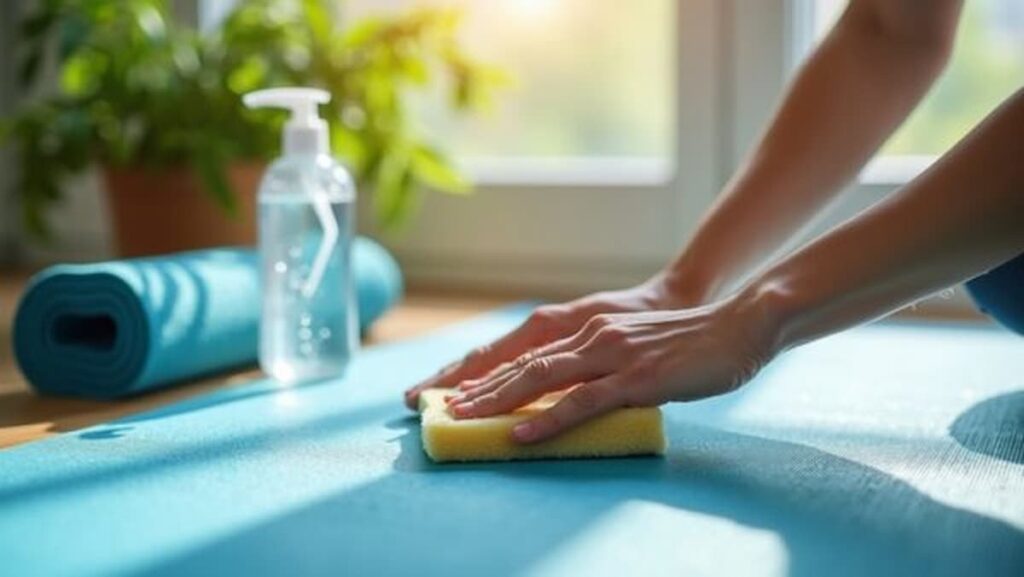
How mobility exercises are important for seniors?
Gaining mobility through targeted exercises can transform seniors' lives by enhancing independence and reducing injury risk, but how exactly does it work?


Keeping your yoga mat clean is key to a better practice, but not all mats are the same. Simple daily wipes and occasional deep cleans can make a big difference, but what’s the best way to do it without damaging your mat?

When selecting a cleaning solution for a yoga mat, it is crucial to contemplate the material composition to avoid damage.
Natural rubber mats require gentle, pH-balanced solutions, while synthetic mats tolerate mild detergents. Harsh chemicals, bleach, or alcohol-based cleaners can degrade the mat’s surface, compromising safety and durability.
Opting for non-toxic, eco-friendly cleaners guarantees effective cleaning without harm.
You may also like: Benefits of Yoga
Regular daily wipe-downs greatly extend a yoga mat’s lifespan by removing sweat, dirt, and oils that accumulate during practice.
Use a soft cloth or sponge dampened with a mild, non-toxic cleaning solution to gently wipe both sides.
Avoid harsh chemicals and excessive moisture to prevent damage.
Allow the mat to air dry completely before rolling or storing to maintain hygiene and safety.
Tackling stubborn stains on a yoga mat requires targeted deep cleaning techniques beyond routine wipe-downs.
A gentle mixture of mild detergent and warm water, applied with a soft cloth or sponge, effectively lifts grime without damaging the mat’s surface.
Avoid harsh chemicals or abrasive tools to maintain material integrity and guarantee safe, toxin-free cleaning.
Rinse thoroughly to remove residue.
After thoroughly cleaning a yoga mat, proper drying and storage are necessary to preserve its condition and prevent mold or unpleasant odors.
Air-drying in a well-ventilated, shaded area is safest. Avoid direct sunlight and heat sources to prevent material damage.
Store the mat rolled loosely in a cool, dry place, ensuring it is completely dry before storage to maintain hygiene and durability.
Regularly wiping it down after use prevents buildup of sweat and dirt. Avoid direct sunlight exposure to reduce material degradation.
Store the mat rolled loosely in a cool, dry place. Using a towel during practice minimizes sweat absorption, enhancing safety and durability.
Proper yoga mat care involves selecting a gentle, pH-balanced cleaner and avoiding harsh chemicals to preserve the mat’s material. Regular daily wiping with a mild solution helps maintain cleanliness, while occasional deep cleaning addresses stubborn stains effectively. Ensuring the mat is fully dry before storage prevents damage and odors. Consistent preventative care not only keeps the mat hygienic but also extends its lifespan, supporting a better yoga practice over time.

Gaining mobility through targeted exercises can transform seniors' lives by enhancing independence and reducing injury risk, but how exactly does it work?

Jumpstart your strength training by syncing workouts with your menstrual cycle—discover the surprising benefits that await when you train with your body’s rhythm.

Get the best techniques to stretch your knee effectively and safely, improving flexibility and preventing injury—discover the key moves you shouldn’t miss.

Learn how stretching before exercise boosts performance and prevents injuries, unlocking benefits you might be missing out on. Discover the key reasons now.

The ultimate guide reveals essential techniques and tips to prevent injuries—discover how simple changes can protect your body and enhance your performance today.

Wondering if stretching after working out is truly mandatory? Discover the surprising benefits and expert insights that might change your routine forever.